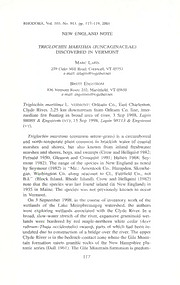
Triglochin maritimum (Juncaginaceae) discovered in Vermont PDF
Preview Triglochin maritimum (Juncaginaceae) discovered in Vermont
RHODORA, No. 117-119, 2001 Vol. 103, 913, pp. NEW ENGLAND NOTE TRIGLOCHIN MARITIMA (JUNCAGINACEAE) VERMONT DISCOVERED IN Marc Lapin VT 239 Cider Mill Road, Cornwall, 05753 [email protected] e-mail: Brett Engstrom VT 836 Vermont Route 05658 232, Marshfield, [email protected] e-mail: Triglochin maritima L. Vermont: Orleans Co., East Charleston, km Clyde 2.25 downstream from Orleans Co. River, line, inter- mediate fen floating in broad area of river, 3 Sep 1998, Lapin & & 98088 Engstrom Sep Lapin 98113 Engstrom (vt); 15 1998, (vt). (common Triglochin maritima arrow-grass) a circumboreal is common and north-temperate plant brackish water of coastal in known marshes and from shores, but also inland freshwater marshes and and swamps (Crow and shores, bogs, Hellquist 1982; Fernald 1950; Gleason and Cronquist 1991; Hulten 1968; Sey- New mour The England 1982). range of the species in as noted by Seymour "Me.: Aroostook Hampden, Skowhe- (1982) Co., is gan, Washington Co. along seacoast to Ct.„ Fairfield Co., not Rhode Crow B.L" (Block and Island, Island). Hellquist (1982) New note that the species was last found inland (in England) in 1935 in Maine. The species was not previously known to occur Vermont. in On September work 3 1998, in the course of inventory of the Memphremagog Lake wetlands of the watershed, the authors were exploring wetlands associated with the Clyde River. In a broad, slow-water stretch of the expansive graminoid wet- river, lands were bordered by red maple-northern white cedar (Acer rub rum— Thuja occidentalis) swamp, parts of which had been in- The undated due to construction of a bridge over the upper river. Moun- Clyde River in the bedrock-contact zone where the Gile is New tain formation meets granitic rocks of the Hampshire plu- The Mountain predom- tonic series (Doll 1961). Gile formation is 117 Rhodora 18 [Vol. 103 1 inantly quartz-muscovite phyllite or schist, but does include it interbedded calcareous mica and quartzose and micaceous schist, A crystalline limestone. wide swath of the Waits River formation, much which contains siliceous crystalline limestone, occurs west from of these wetlands. Glacial drift the limestone likely enriches Many the soils in this portion of the Clyde River valley. of the show wetlands there a pronounced influence of calcareous en- richment and seepage waters. in soils We maneuvered our canoe through patches of (Typha cattail and pickerelweed (Pontederia cordata and latifolia L.) L.) stepped out onto a floating mat dominated by Carex lasiocarpa Upon Ehrh. and Myrica gale soggy, mat of sedge L. this floating we cm happened upon 45 stem peat, a fruiting of Triglochin tall, we maritima. Searching the immediate area, discovered in total m We three and three vegetative stems 100 2 fertile in a area. later returned to the site to better quantify the population and to char- ecosystem which Our acterize the occurred. count in final for it the 1998 season was 27 fruiting stems in a one-half hectare area. we Leaves had largely withered this late in the season, thus were unable to count vegetative individuals. Other associated plant spe- included Menyanthes Dulichium arundinaceum cies trifoliata L., (L.) Britton, Potentilla palustris (L.) Scop., Vacciniwn macro- carpon Aiton, Bidens cernuus L. var. minimus (Huds.) Pursh, Ci- cuta bulbifera Eriocaulon aquaticum Druce, Rhynchos- L., (Hill) pora alba Vahl, Triadenum (Spach) Gleason, (L.) fraseri Utri- cularia gibba L., Cladium mariscoides (Muhl.) Torn, and Salix uncommon The pedicellaris Pursh. latter three species are rare or Vermont. Triglochin maritima grew on both and non- in floating was decomposed floating parts of the fen; the peat poorly and m ranged from to 3 deep. 1 work Continuing inventory wetland complex, the the vast in we explored the wide open, glade-like landscape of meandering We meadow, sedge intermediate fen and shrub swamp. river, know of no similar landscape Vermont. Despite hours of in many meadow we searching hectares of sedge and discovered fen, no additional plants of Triglochin maritima. The new plant discovery and additional information about the wetlands in this portion of the Clyde River were later useful in easement planning farmland conservation Although for a project. a small part of the wetland ecosystem was impacted by bridge some construction years ago, portion o( the Clyde River and this New England Note 119 2001] the associated wetlands remain a high-quality natural area that deserves and protection appreciation. acknowledgments. work was This part of a project of the Nongame and Natural Heritage Program, Vermont Fish and Wild- EPA life Department, and was funded by a U.S. wetlands pro- We tection grant. thank Barre Hellquist, Cathy Paris, and an anon- ymous reviewer comments. for their helpful LITERATURE CITED Crow, and New G. E. C. B. Hlllqulst. 1982. Aquatic vascular plants of England: Part Juncaginaceae, Scheuchzeriaceae, Butomaceae, Hydro- 4. New Hampshire Durham, NH. charitaceae. Agric. Exp. Sta. Bull. 520, Map Doll, C. G. 1961. Centennial Geologic of Vermont. Vermont Geological Survey, Waterbury, VT. Fernald, M. Manual L. 1950. Gray\s of Botany, 8th ed. Dioscorides Press, OR. Portland, Glfason, H. A. and A. Cronquist. 1991. Manual of Vascular Plants of New Northeastern United and Adjacent Canada, 2nd The York States ed. Botanical Garden, Bronx, NY. Hulten, E. 1968. Flora of Alaska and Neighboring Territories. Stanford Univ. CA. Press, Stanford, New Shymour, C. 1982. The Flora of England, 2nd ed. Privately printed. F.
